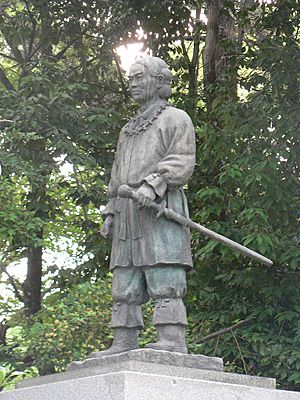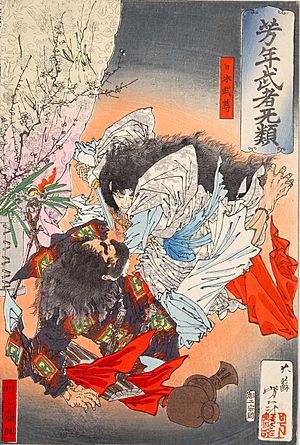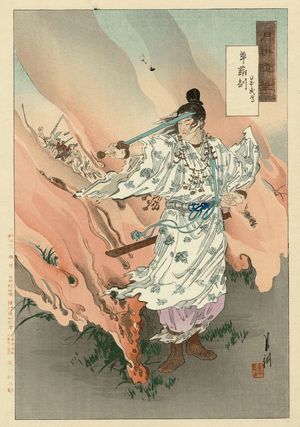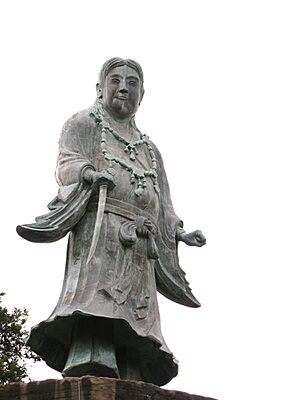Yamato Takeru facts for kids
Yamato Takeru (ヤマトタケルノミコト), originally called Prince Ousu (小碓命), was a famous legendary prince from ancient Japan. He was the son of Emperor Keikō, who was the 12th Emperor of Japan. His name can be written in different ways in old Japanese books, like 日本武尊 in the Nihon Shoki and 倭建命 in the Kojiki.
His exciting life story is mainly told in two old Japanese books: the Kojiki (written in 712 AD) and the Nihon Shoki (written in 720 AD). His adventures are also mentioned in other historical writings. One of his sons later became Emperor Chūai, the 14th Emperor of Japan.
While we don't know all the exact details of his life, these old stories suggest he lived a long time ago, possibly from around 72 AD to 114 AD. The Kojiki version of his story is thought to be closer to the original legends.
Contents
The Brave Prince's Adventures
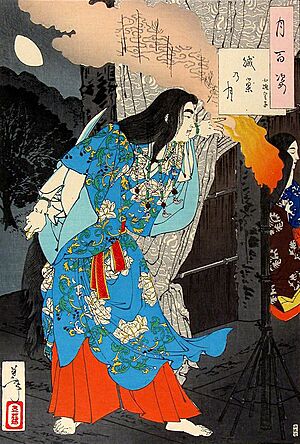
Prince Takeru was known for his strong and sometimes fierce personality. Because of this, his father, Emperor Keikō, was a bit worried about him. To keep him busy and far away, the Emperor sent him on important missions. First, he went to Izumo Province (which is now part of Shimane Prefecture). After that, he was sent to the land of Kumaso (now Kumamoto Prefecture).
Yamato Takeru was very successful in defeating his enemies. In Kumaso, he even dressed up as a maidservant at a party to surprise and defeat the leaders! One of the enemies he defeated was so impressed by his bravery that he gave him the name Yamato Takeru. This name means "The Brave of Yamato." Even with these victories, Emperor Keikō still felt uneasy about his son.
A Journey to the East
Next, Emperor Keikō sent Yamato Takeru to the eastern lands. The people there were not following the rules of the imperial court. On his way, Yamato Takeru visited his aunt, Princess Yamato-hime. She was the most important priestess of the sun goddess Amaterasu at the Ise Grand Shrine. Yamato Takeru felt sad and asked his aunt if his father wanted him to die on these dangerous missions.
Princess Yamatohime-no-mikoto felt sorry for him. She gave him a very special and holy sword called Ame no Murakumo no tsurugi (also known as Kusanagi no tsurugi). This sword was found by Susanoo, the brother of Amaterasu, inside a giant eight-headed serpent called Yamata no Orochi. With this powerful sword, Yamato Takeru continued his journey to the eastern lands.
During his adventures, he faced many challenges. He sadly lost his wife, Oto tachibana-hime, during a big storm at sea. She bravely sacrificed herself to calm the angry sea god. Yamato Takeru defeated many enemies in the east. It's even said that he and an old man from the area created the first sedōka (a type of Japanese poem) in Kai Province, inspired by Mount Tsukuba.
The Final Challenge
On his way back home, Yamato Takeru made a mistake. He disrespected a local god of Mount Ibuki, a mountain on the border of Ōmi Province and Mino Province. The god became angry and cursed him with a terrible sickness. Yamato Takeru became very ill.
The story of Yamato Takeru's life and challenges is mainly found in the Kojiki. However, in the Nihonshoki version, his relationship with his father, Emperor Keikō, is shown as being much better.
The End of a Legend
According to old records, Yamato Takeru died in the 43rd year of Emperor Keiko's rule. After he passed away, his belongings, including the sacred sword Kusanagi, were collected. His wife kept his memory alive in a shrine at her home. Later, these important items, including the sword, were moved to where the Atsuta Shrine is today.
It is believed that Yamato Takeru died somewhere in Ise Province. Legend says that the name of Mie Prefecture comes from his very last words. After his death, his spirit is said to have turned into a large white bird and flown away. His tomb in Ise is known as the Mausoleum of the White Plover. Today, you can find a statue of Yamato Takeru in Kenroku-en in Kanazawa, Ishikawa.
See also
 In Spanish: Yamato Takeru para niños
In Spanish: Yamato Takeru para niños


